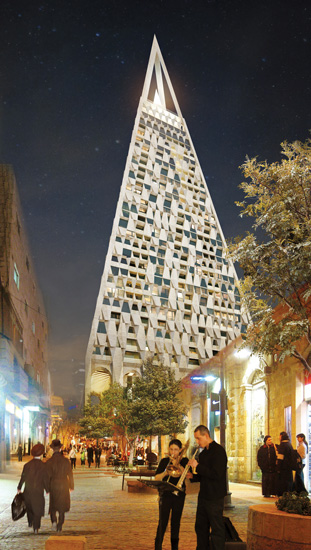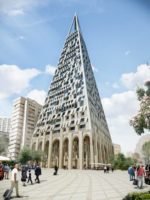Libeskind's Jerusalem Tower Chopped, But Not Tossed

A rendering of Daniel Libeskind’s controversial Pyramid tower set to rise in Jerusalem. City officials slashed the height of the tower by one-third in late October.
Photo © Vingtsix
The controversy surrounding Daniel Libeskind’s planned stone-and-glass pyramidal tower in Jerusalem reached fever pitch late last month. Following impassioned objections by groups and individuals, the city approved the plan on October 28th, but with major revisions. The officials reduced the height of the mixed-use building by more than one-third, from 539 feet to 355 feet. Additionally, they ordered the architect to replace the arched arcade around the base with retail businesses that open to the street, and forbade the placement of communication devices, such as cell phone towers, above the apex. A 10-year time frame was stipulated for completion.
Asked whether he would stay with the project despite the setback, Libeskind said in an e-mail, “We will continue full-speed ahead.” Neither the building’s pyramid shape nor its program—apartments, a boutique hotel, a museum, and an observation platform with a restaurant and café—will change, he claims.
The tower, which Libeskind calls “The Pyramid,” is set to rise on a 1.7-acre plot in Jerusalem’s downtown, near the Mahane Yehuda produce market, and surrounded by old, low-rise neighborhoods. In 2012 the city approved a Libeskind-designed 24-story tower (not a pyramid) for the site. This year, the architect, working with a new developer, sought—and won—initial approval for a different, and much taller, design.
During the summer, after excavation had begun and the city had posted a plan for public responses, critics voiced concern that the luxury tower would exacerbate the phenomenon of ghost apartments in the city—that is, luxury apartments occupied only briefly each year by foreign owners. Other critics joined the fray, particularly the Jerusalem branch of the Israel Association of United Architects (IAUA), which argued that there had been no public debate over the project and that approval had been granted by the city’s planning committee, which consists of politicians, without the professional oversight of the Jerusalem District Planning Commission.
The association convened a public discussion on October 18, for which Libeskind and his wife and partner, Nina, flew in. Some 150 architects, geographers, and conservationists attended. Libeskind said he shared the developer’s vision of creating a “wow” for the city, and that in a visit to Jerusalem to discuss the project, Mayor Nir Barkat had asked only whether it would be taller than the Egyptian pyramids. Libeskind assured Barkat it would be.
Opponents objected that Jerusalem is already a “wow” and does not need another tourist attraction. Many argued that the massive project was insensitive to the city’s fabric, which was built up over centuries. Others objected to the proposed height, which grossly exceeded the 24-story limit set for the historical heart of the city by the municipal outline plan of 2000. Libeskind’s associate on the project, Jerusalem architect Igal Levi, countered by saying that the tall, hollow apex “is just air."
Levi opened the door to objections by stating earlier that the pyramid is a Jewish symbol. In fact, many would agree that it is instead a grating reminder of the biblical story of the Israelites’ enslavement in Egypt. The objectors countered with the biblical tale of the Tower of Babel. Some suggested that, at the very least, the project be moved away from the historical downtown.
The Pyramid Tower is to be Libeskind’s second project in Israel. His one built project, a conference center in Tel Aviv, was completed in 2005. Looking ahead, the architect says, “Several projects are under way in Israel.”


